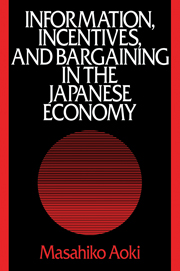 Information, Incentives and Bargaining in the Japanese Economy
Information, Incentives and Bargaining in the Japanese Economy Book contents
- Frontmatter
- Contents
- List of figures
- List of tables
- Preface
- 1 Introduction
- 2 The information structure of the J-firm
- 3 The ranking hierarchy of the J-firm as incentive scheme
- 4 Corporate finance, stockholding returns, and corporate governance structure
- 5 Bargaining game at the J-firm
- 6 The changing nature of industrial organization
- 7 Bureaupluralism
- 8 Culture and economic rationality
- Author index
- Subject index
4 - Corporate finance, stockholding returns, and corporate governance structure
Published online by Cambridge University Press: 14 January 2010
- Frontmatter
- Contents
- List of figures
- List of tables
- Preface
- 1 Introduction
- 2 The information structure of the J-firm
- 3 The ranking hierarchy of the J-firm as incentive scheme
- 4 Corporate finance, stockholding returns, and corporate governance structure
- 5 Bargaining game at the J-firm
- 6 The changing nature of industrial organization
- 7 Bureaupluralism
- 8 Culture and economic rationality
- Author index
- Subject index
Summary
In Chapter 2, we saw that the A-firm relies on economies of specialization. This characteristic has generated two important consequences: the development of well-organized markets external to the firm for standardized jobs; and the emergence of job-control unionism, under which jobs are allocated and paid within the firm according to the well-articulated job-evaluation scheme. Economists have come to call this intrafirm job allocation mechanism the internal labor market. The widely accepted neoclassical notion of the firm has been formulated to reflect such developments. The basic rates of pay for all employees of the firm, including managers, are determined in the external and internal labor markets, and the residual of revenue after all contractual payment is made - that is, the quasi rent in economic terminology - is accruable to the ultimate controller of the firm. This ultimate controller cum residual claimant is identified with the body of stockholders. This body exercises, or should be made to exercise if it does not or is prevented from doing so, ultimate control over the business and affairs of the firm by selecting the board of directors, which is in turn responsible for selecting the executive management responsible for the hierarchical control of the internal labor market.
On the other hand, a reasonable impression for the reader to have gained so far may be that the quasi-permanent employee of the J-firm has achieved a clear status in the firm that does not dissolve in the market mechanism.
- Type
- Chapter
- Information
- Information, Incentives and Bargaining in the Japanese EconomyA Microtheory of the Japanese Economy, pp. 99 - 149Publisher: Cambridge University PressPrint publication year: 1988


